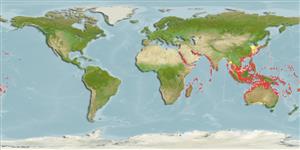Classificação / Names
Common names from other countries
Referência principal
Tamanho / Peso / Idade
Max length : 30.0 cm TL macho/indeterminado; (Ref. 30573); common length : 26.0 cm TL macho/indeterminado; (Ref. 30573)
Length at first maturity
Lm ?, range 17 - ? cm
Ambiente
; marinhas; estuarina associadas(os) a recifes; intervalo de profundidade 1 - 80 m (Ref. 58302)
Clima / Intervalo
Tropical, preferred 27°C (Ref. 107945); 35°N - 35°S, 32°E - 169°W
Distribuição
Indo-Pacific: Red Sea and the east coast of Africa to the Hawaiian Islands and Samoa, north to Japan (Ref. 559), south to the Arafura Sea (Ref. 9819) and northern Australia.
Países | Áreas FAO | Ecossistemas | Ocorrências | Introduções
Descrição breve
Espinhos dorsais (total): 9; Raios dorsais moles (total): 22-25; Espinhos anais 3; Raios anais moles: 18 - 21.
Categoria na Lista Vermelha da IUCN (Ref. 115185)
Ameaça para o homem
Harmless
Utilização humana
Pescarias: pouco comercial; peixe desportivo: sim
Mais informação
ReferênciasAquaculturaPerfil para aquaculturaEstirpesGenéticaFrequência dos alelosHereditariedadeDoençasProcessamentoMass conversion
Ferramentas
Relatórios especiais
Descarregue XML
Fontes da internet
Estimates of some properties based on models
Phylogenetic diversity index
PD50 = 1.0000 many relatives (e.g. carps) 0.5 - 2.0 few relatives (e.g. lungfishes)
Nível Trófico
4.2 ±0.5 se; Based on diet studies.
Resiliência
Elevada, tempo mínimo de duplicação da população menor que 15 meses (K=0.58-1.00; Fec=63,000-161,000 (batch fecundity))
Vulnerabilidade
Low vulnerability (19 of 100)
Categoria de preço
